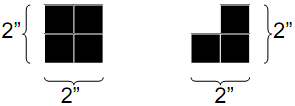当前你的浏览器版本过低,网站已在兼容模式下运行,兼容模式仅提供最小功能支持,网站样式可能显示不正常。
请尽快升级浏览器以体验网站在线编辑、在线运行等功能。
3818:Mosaic
题目描述
An architect wants to decorate one of his buildings with a long, thin mosaic. He has two kinds of tiles available to him, each 2 inches by 2 inches:

He can rotate the second kind of tile in any of four ways. He wants to fill the entire space with tiles, leaving no untiled gaps. Now, he wonders how many different patterns he can form. He considers two mosaics to be the same only if they have exactly the same kinds of tiles in exactly the same positions. So, if a rotation or a reflection of a pattern has tiles in different places than the original, he considers it a different pattern. The following are examples of 4” x 16” mosaics, and even though they are all rotations or reflections of each other, the architect considers them to be four different mosaics:


He can rotate the second kind of tile in any of four ways. He wants to fill the entire space with tiles, leaving no untiled gaps. Now, he wonders how many different patterns he can form. He considers two mosaics to be the same only if they have exactly the same kinds of tiles in exactly the same positions. So, if a rotation or a reflection of a pattern has tiles in different places than the original, he considers it a different pattern. The following are examples of 4” x 16” mosaics, and even though they are all rotations or reflections of each other, the architect considers them to be four different mosaics:

输入解释
There will be several test cases. Each test case will consist of two integers on a single line, N and M (2 ≤ N ≤ 10, 2 ≤ M ≤ 500). These represent the dimensions of the strip he wishes to fill, in inches. The data set will conclude with a line with two 0's.
输出解释
For each test case, print out a single integer representing the number of unique ways that the architect can tile the space, modulo 106. Print each integer on its own line, with no extra whitespace. Do not print any blank lines between answers.
输入样例
2 10 4 16 4 50 0 0
输出样例
25 366318 574777
最后修改于 2020-10-29T07:12:49+00:00 由爬虫自动更新
共提交 0 次
通过率 --%
| 时间上限 | 内存上限 |
| 1000 | 65536 |
登陆或注册以提交代码